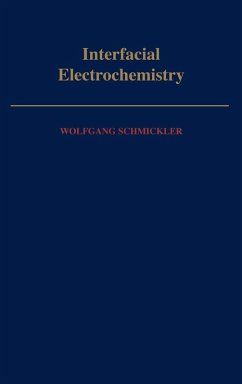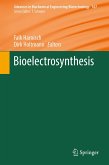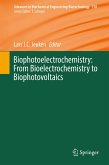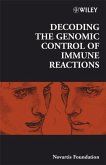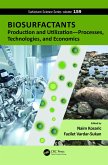Interfacial Electrochemistry (eBook, PDF)


Alle Infos zum eBook verschenken

Interfacial Electrochemistry (eBook, PDF)
- Format: PDF
- Merkliste
- Auf die Merkliste
- Bewerten Bewerten
- Teilen
- Produkt teilen
- Produkterinnerung
- Produkterinnerung

Hier können Sie sich einloggen

Bitte loggen Sie sich zunächst in Ihr Kundenkonto ein oder registrieren Sie sich bei bücher.de, um das eBook-Abo tolino select nutzen zu können.
Electrochemistry is the study of a special class of interfaces--those between an ionic and an electronic conductor--that can conduct current. This makes it especially important to research and for industrial applications such as semiconductors. This book examines different topics within interfacial electrochemistry, including the theory of structures and processes at metal- solution and semiconductor-solution interfaces, the principles of classical and modern experimental methods, and some of the applications of electrochemistry. Students and nonspecialists in materials science, surface…mehr
- Geräte: PC
- mit Kopierschutz
- eBook Hilfe
- Größe: 13.16MB
![Bioelectrosynthesis (eBook, PDF) Bioelectrosynthesis (eBook, PDF)]() Bioelectrosynthesis (eBook, PDF)233,95 €
Bioelectrosynthesis (eBook, PDF)233,95 €![Biophotoelectrochemistry: From Bioelectrochemistry to Biophotovoltaics (eBook, PDF) Biophotoelectrochemistry: From Bioelectrochemistry to Biophotovoltaics (eBook, PDF)]() Biophotoelectrochemistry: From Bioelectrochemistry to Biophotovoltaics (eBook, PDF)193,95 €
Biophotoelectrochemistry: From Bioelectrochemistry to Biophotovoltaics (eBook, PDF)193,95 €![Decoding the Genomic Control of Immune Reactions (eBook, PDF) Decoding the Genomic Control of Immune Reactions (eBook, PDF)]() Decoding the Genomic Control of Immune Reactions (eBook, PDF)161,99 €
Decoding the Genomic Control of Immune Reactions (eBook, PDF)161,99 €![Optical Rheometry of Complex Fluids (eBook, PDF) Optical Rheometry of Complex Fluids (eBook, PDF)]() Gerald G. FullerOptical Rheometry of Complex Fluids (eBook, PDF)86,95 €
Gerald G. FullerOptical Rheometry of Complex Fluids (eBook, PDF)86,95 €![Biosurfactants (eBook, PDF) Biosurfactants (eBook, PDF)]() Biosurfactants (eBook, PDF)46,95 €
Biosurfactants (eBook, PDF)46,95 €- -24%11
![Chemie für Ingenieure (eBook, PDF) Chemie für Ingenieure (eBook, PDF)]() Dirk FlottmannChemie für Ingenieure (eBook, PDF)49,44 €
Dirk FlottmannChemie für Ingenieure (eBook, PDF)49,44 € ![Phenotypic Plasticity (eBook, PDF) Phenotypic Plasticity (eBook, PDF)]() Phenotypic Plasticity (eBook, PDF)88,95 €
Phenotypic Plasticity (eBook, PDF)88,95 €-
-
-
Dieser Download kann aus rechtlichen Gründen nur mit Rechnungsadresse in A, B, BG, CY, CZ, D, DK, EW, E, FIN, F, GR, HR, H, IRL, I, LT, L, LR, M, NL, PL, P, R, S, SLO, SK ausgeliefert werden.
- Produktdetails
- Verlag: Oxford University Press
- Erscheinungstermin: 29. Februar 1996
- Englisch
- ISBN-13: 9780195358315
- Artikelnr.: 38144075
- Verlag: Oxford University Press
- Erscheinungstermin: 29. Februar 1996
- Englisch
- ISBN-13: 9780195358315
- Artikelnr.: 38144075
1: Preliminaries
2: The Metal-Solution Interface
3: Adsorption on Metal Electrodes
4: Electron Transfer Reactions
5: Theory of ET Reactions
6: Semiconductor Electrodes
7: Experimental Results
8: Proton and Ion Transfer Reactions
9: Metal Deposition and Dissolution
10: Complex Reactions
11: Liquid-Liquid Interfaces
12: Transient Techniques
13: Convection Techniques
14: Non-traditional Techniques
15: Thermodynamics
16: The Double Layer
17: Charge Distribution in Adsorbates
18: Quantum Theory of ET Reactions
1: Preliminaries
2: The Metal-Solution Interface
3: Adsorption on Metal Electrodes
4: Electron Transfer Reactions
5: Theory of ET Reactions
6: Semiconductor Electrodes
7: Experimental Results
8: Proton and Ion Transfer Reactions
9: Metal Deposition and Dissolution
10: Complex Reactions
11: Liquid-Liquid Interfaces
12: Transient Techniques
13: Convection Techniques
14: Non-traditional Techniques
15: Thermodynamics
16: The Double Layer
17: Charge Distribution in Adsorbates
18: Quantum Theory of ET Reactions
